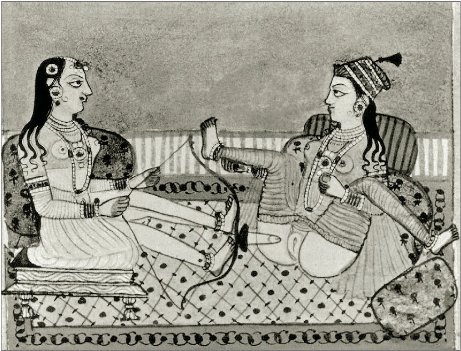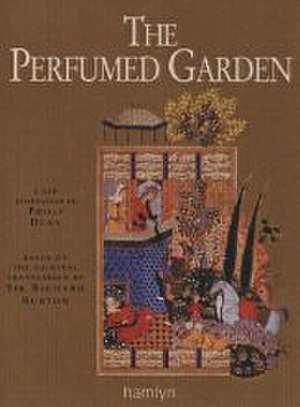10. Thigh Fencing and the Saffron Massage
/In this episode, cohosts Gretchen and Leigh will take you on a tour of medieval Arabo-Islamic erotic literature and the many delightful descriptions of queer female experience it contains. Remember way back in episode two when ‘thigh fencing’ came up? Well, that and other martial imagery for wlw sexual experience come from medieval Arabo-Islamic poetry! Like shield banging, jousting without a lance, or our new favorite---the saffron massage. Love stories of cross dressing heroines who marry women? Then you’ll love Princess Budur and her wife Hayat. We’ve got another word of the week focused on queer female self-description, medical explanations for wlw preferences, and the music of love (moaning). We’ll also chat about the Arabic Sappho and the first lesbian couple, Hind and al-Zarqa’!
Just a warning, some of the images and poems are NSFW, so best read this at home.
Arabic Erotica and Sex Manuals
17th century, unknown Persian miniaturist depicts of sapphic women with a creative looking dildo. (thought we didn't have a lesbian emoji? surprise, now you do.)
The Perfumed Garden
Cover of Richard Francis Burton's 1886 translation of Muhammad al-Nafzawi's text.
In chapter 9 of The Perfumed Garden, one of the best known of the medieval Arabo-Islamic sex manuals, we get a long list of 'sundry names' for the vulva. The whole thing is both delightful and humorous, but we wanted to quote you this section on dreaming about seeing a vulva:
The person who dreams of having seen the vulva, feurdj, of a woman will know that "if he is in trouble God will free him of it; if he is in a perplexity he will soon get out of it; and lastly if he is in poverty he will soon become wealthy, because feurdj, by transposing the vowels, will mean the deliverance from evil. By analogy, if he wants a thing he will get it; if he has debts, they will be paid."
It is considered more lucky to dream of the vulva as open. But if the one seen belongs to a young virgin it indicates that the door of consolation will remain closed, and the thing which is desired is not obtainable. It is a proved fact that the man who sees in his dream the vulva of a virgin that has never been touched will certainly be involved in difficulties, and will not be lucky in his affairs. But if the vulva is open so that he can look well into it, or even if it is hidden but he is free to enter it, he will bring the most difficult tasks to a successful end after having first failed in them, and this after a short delay, by the help of a person whom he never thought of.
Full text of Burton's translation of The Perfumed Garden is available here.
The Tale of Qamar al-Zaman and Princess Budur: The Story That Keeps Getting Better
Illustration of Princess Budur, done by Edmund Dulac, for the 1907 edition of The Arabian Nights for Hodder & Stoughton.
We weren't able to find illustrations of Budur and Hayat, so here is one of Qamar and Budur from the 1958 Italian Young Readers book Le Mille E Una Notte. You can find more illustrations of this tale from this edition here.
Illustration of Qamar and Budur from the 1915 edition of More Tales from the Arabian Nights.
This tale was Gretchen's absolute favorite discovery in researching for this episode. What an utterly delightful story! After recording the podcast, she found new articles on the story that discuss the gender flipping and sexuality of Budur and Qamar on another level, namely, that of Budur taking the dominant male role in a m/m interaction when she and her husband reunite. Budur even propositions Qamar---while disguised as a man---using gay poetry:
My pintle is big and the little one said unto me,
"Tilt boldly therewith at my inwards and quit thee thy need."
Quoth I, "'Tis unlawful;" but he, "It is lawful with me;"
So to it I fell, supporting myself by his rede.'
--
The penis smooth and round was made with anus best to match it,
Had it been made for cunnus' sake it had been formed like a hatchet!
Wow. (What we want to know is, where did Budur learn this, or is she just that good at making up gay poetry?) All that to say, there are even more layers to the story that mess with cisheteronormativity! This is the best story ever, and we honestly need an adaptation of it yesterday. Full text of "The Tale of Qamar al-Zaman and Princess Budur" can be found here and here.
If you want to learn more about queer women in the medieval Arabo-Islamic Literary Tradion, check out our full list of sources and further reading below!
Books and Print Articles:
Sahar Amer, Crossing Borders: Love Between Women in Medieval French and Arabic Literatures
Sahar Amer, "Medieval Lesbians and Lesbian-Like Women" in Journal of the History of Sexuality (Vol 18, no 2, 2009).
Sahar Amer, "Cross Dressing and Female Same-Sex Marriage in Medieval French and Arabic Literature" in Islamicate Identities
Sahar Amer, "Lesbian Sex and the Military: From the Medieval Arabic Tradition to French Literature" in Same Sex Love and Desire Among Women in the Middle Ages
Fedwa Malti-Douglas, "Tribadism/Lesbianism and the Sexualized Body in Medieval Arabo-Islamic Narratives" in Same Sex Love and Desire Among Women in the Middle Ages
Samar Habib, Arabo-Islamic Texts on Female Homosexuality 850-1780 A.D.
Samar Habib, Female Homosexuality in the Middle East: Histories and Representations
Kathryn Babayan, "'In Spirit We Ate Each Other's Sorrow': Female Companionship in Seventeenth Century Safavi Iran" in Islamicate Identities
Stephen O. Murray "Woman-Woman Love in Islamic Society" in Islamic Homosexualities
As'ad AbuKhalil, "A Note on the Study of Homosexuality in the Arab/Islamic Civilization" in The Arab Studies Journal (Vol 1, no 2, 1993)






